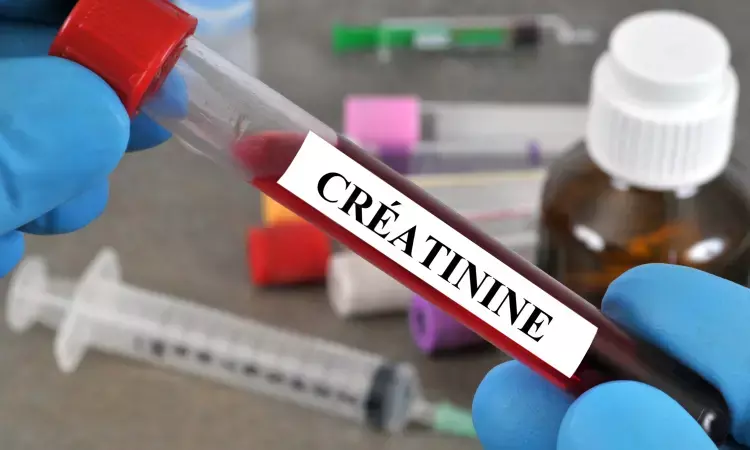- Home
- Medical news & Guidelines
- Anesthesiology
- Cardiology and CTVS
- Critical Care
- Dentistry
- Dermatology
- Diabetes and Endocrinology
- ENT
- Gastroenterology
- Medicine
- Nephrology
- Neurology
- Obstretics-Gynaecology
- Oncology
- Ophthalmology
- Orthopaedics
- Pediatrics-Neonatology
- Psychiatry
- Pulmonology
- Radiology
- Surgery
- Urology
- Laboratory Medicine
- Diet
- Nursing
- Paramedical
- Physiotherapy
- Health news
- Fact Check
- Bone Health Fact Check
- Brain Health Fact Check
- Cancer Related Fact Check
- Child Care Fact Check
- Dental and oral health fact check
- Diabetes and metabolic health fact check
- Diet and Nutrition Fact Check
- Eye and ENT Care Fact Check
- Fitness fact check
- Gut health fact check
- Heart health fact check
- Kidney health fact check
- Medical education fact check
- Men's health fact check
- Respiratory fact check
- Skin and hair care fact check
- Vaccine and Immunization fact check
- Women's health fact check
- AYUSH
- State News
- Andaman and Nicobar Islands
- Andhra Pradesh
- Arunachal Pradesh
- Assam
- Bihar
- Chandigarh
- Chattisgarh
- Dadra and Nagar Haveli
- Daman and Diu
- Delhi
- Goa
- Gujarat
- Haryana
- Himachal Pradesh
- Jammu & Kashmir
- Jharkhand
- Karnataka
- Kerala
- Ladakh
- Lakshadweep
- Madhya Pradesh
- Maharashtra
- Manipur
- Meghalaya
- Mizoram
- Nagaland
- Odisha
- Puducherry
- Punjab
- Rajasthan
- Sikkim
- Tamil Nadu
- Telangana
- Tripura
- Uttar Pradesh
- Uttrakhand
- West Bengal
- Medical Education
- Industry
Rare case of Pseudohypercreatininemia after surgery for aortic dissection: A report

Creatinine levels are considered to be the gold standard to define kidney functioning in patients. Elevated creatinine concentrations often indicate acute renal injury and renal biopsies are most preferred diagnostic methods in this situation. Creatinine may be measured using the Jaffe method and enzymatic methods. The latter has high specificity and is used by many medical institutions
Paraproteins can interfere in the determination of various clinically important analytes in an unpredictable manner affecting different methodologies. Interferences of mild to moderate degree have been reported affecting the measurement of serum creatinine. Pseudohypercreatininemia caused by immunoglobulin (Ig)M which can be misleading, but there are no reports of pseudohypercreatininemia.
A case study in BMC Nephrology reports a rare case of a women with falsely elevated creatinine concentration with the presence of abnormal proteins, pseudohypercreatininemia should be considered as a differential diagnosis and prevent invasive procedures in the patients.
A 54-year-old woman underwent surgery for descending aortic dissection. At admission, she had developed another aortic dissection in the descending aorta and underwent graft replacement. She had multiple aortic dissections at a young age, but had no findings or family history of Marfan syndrome or Ehlers–Danlos syndrome. Because of severe intraoperative bleeding, she was transfused with 10 units of red blood cells, 4 units of fresh-frozen plasma, and 10 units of platelets, and her creatinine concentration was approximately 1 mg/dl. Nine days postoperatively, her creatinine concentration increased from 1 mg/dl to 5.78 mg/dl. Azotemia and hyperkalemia were absent and physical examination findings were unremarkable.
The case study found that
• Cystatin C concentration was 1.56 mg/l (normal range, 0.56–0.8 mg/l) and pseudohypercreatininemia was suspected.
• Testing with different reagents showed a creatinine concentration of 0.84 mg/dl. Immunoglobulin (Ig)G was markedly elevated, and creatinine and IgG fluctuated in parallel, suggesting the cause of the pseudohypercreatininemia.
• IgG4 was also elevated at 844 mg/dl. Immunosuppressive steroid therapy effectively decreased the IgG concentration and resolved the pseudohypercreatininemia.
Researchers concluded that “In cases of elevated creatinine concentration with the presence of abnormal proteins, pseudohypercreatininemia should be considered. We report a rare case of pseudohypercreatininemia caused by polyclonal IgG.”
Reference: Tasaki, A., Fukuda, M., Ikeda, Y. et al. Pseudohypercreatininemia after surgery for aortic dissection: a case report. BMC Nephrol 24, 220 (2023). https://doi.org/10.1186/s12882-023-03275-2
MSc. Neuroscience
Niveditha Subramani a MSc. Neuroscience (Faculty of Medicine) graduate from University of Madras, Chennai. Ambitious in Neuro research having worked in motor diseases and neuron apoptosis is interested in more of new upcoming research and their advancement in field of medicine. She has an engrossed skill towards writing and her roles at Medical dialogue include Sr. Content writer. Her news covers new discoveries and updates in field of medicine. She can be reached at editorial@medicaldialogues.in
Dr Kamal Kant Kohli-MBBS, DTCD- a chest specialist with more than 30 years of practice and a flair for writing clinical articles, Dr Kamal Kant Kohli joined Medical Dialogues as a Chief Editor of Medical News. Besides writing articles, as an editor, he proofreads and verifies all the medical content published on Medical Dialogues including those coming from journals, studies,medical conferences,guidelines etc. Email: drkohli@medicaldialogues.in. Contact no. 011-43720751


